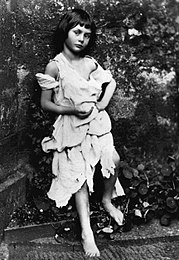In 1856, Dodgson took up the new art form of photography, first under the influence of his uncle Skeffington Lutwidge, and later his Oxford friend Reginald Southey.
He soon excelled at the art and became a well-known gentleman-photographer, and he seems even to have toyed with the idea of making a living out of it in his very early years.
A recent study by Roger Taylor and Edward Wakeling exhaustively lists every surviving print, and Taylor calculates that just over fifty percent of his surviving work depicts young girls. He would later use many of his photographs of children in conjunction with his writings to add illustration to his work. Alexandra Kitchin, known as "Xie" (pronounced "Ecksy"), was his favourite photographic subject. From 1869 until he gave up photography in 1880, Dodgson photographed her at least fifty times, ending just before her sixteenth birthday. Less than a third of his original portfolio has survived, however; Dodgson also made many studies of men, women, male children and landscapes; his subjects also include skeletons, dolls, dogs, statues and paintings, trees, scholars, scientists, old men and little girls. His studies of nude children were long presumed lost, but six have since surfaced, five of which have been published.
He also found photography to be a useful entrée into higher social circles. During the most productive part of his career, he made portraits of notable sitters such as John Everett Millais, Ellen Terry, Dante Gabriel Rossetti, Julia Margaret Cameron, Michael Faraday and Alfred, Lord Tennyson.
Dodgson abruptly ceased photography in 1880. Over 24 years, he had completely mastered the medium, set up his own studio on the roof of Tom Quad, and created around 3,000 images. Fewer than 1,000 have survived time and deliberate destruction. His reasons for abandoning photography remain uncertain.
With the advent of Modernism tastes changed, and his photography was forgotten from around 1920 until the 1960s. He is now considered by many to be one of the very best Victorian photographers, and is certainly the one who has had the most influence on modern art photographers.

